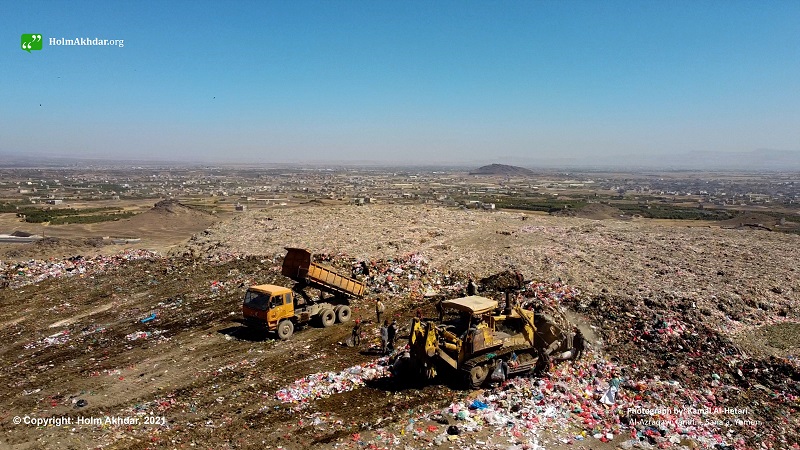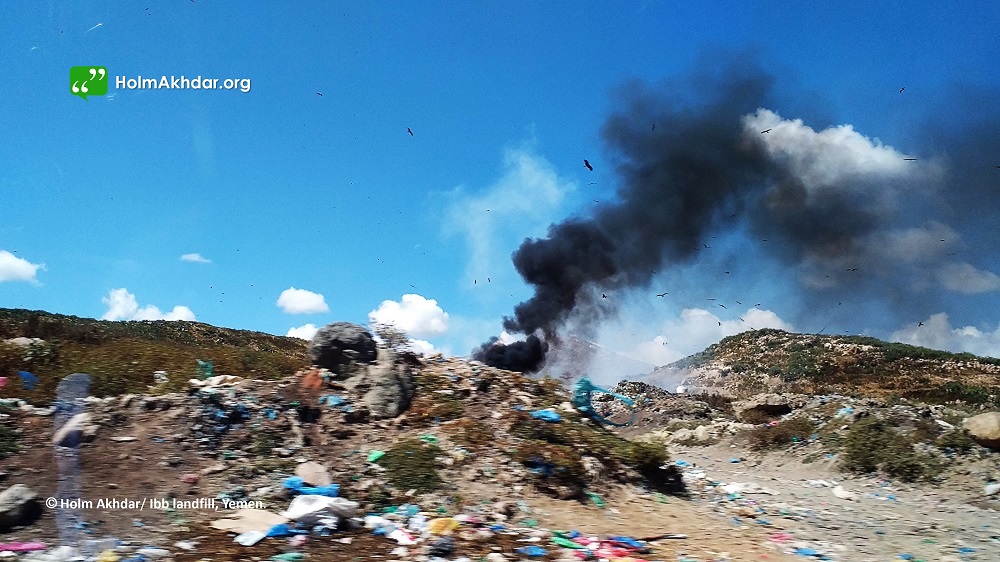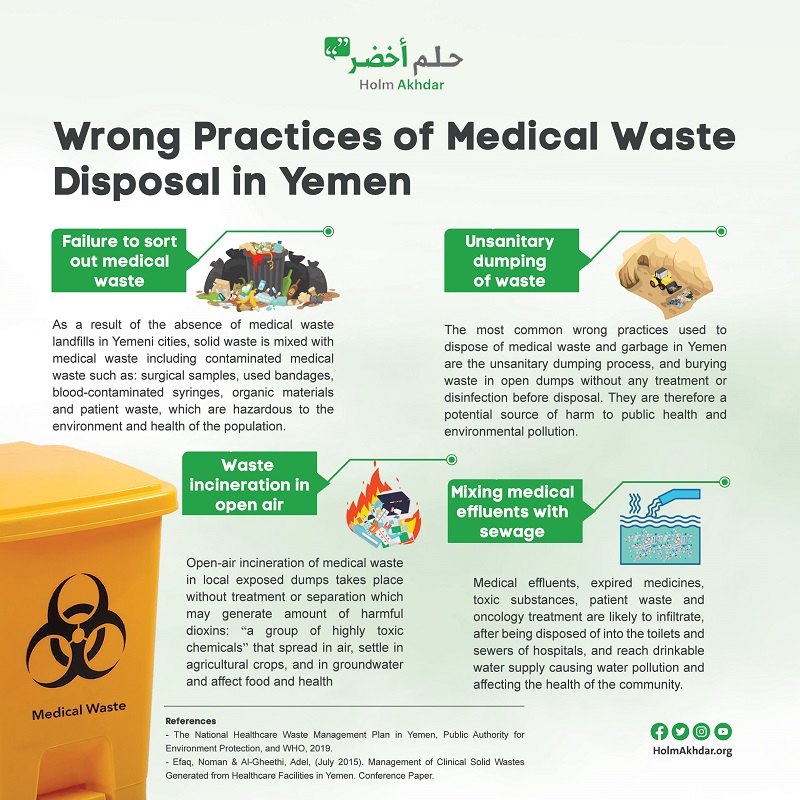By: Holm Akhdar Team (Sana’a)
On the 60th Street, in the center of Yemen’s capital, Sana’a, hundreds of tons of solid waste are collected and accumulated together with medical waste, 20% of which are hazardous to the environment and the health of the population.
All this waste is transported outside the city and buried inside the main landfill in (Al-Azraqain) area, in the district of (Bani Al-Harith), which is mostly agricultural crop-producing lands.
This landfill (Al-Azraqain), located on the direction of the north winds, receives waste of three governorates. It is estimated at 1,500 tons a day, according to the Emergency Waste Assessment (UNDP).

A landfill for Three Governorates
In an interview with “Holm Akhdar”, the Director of Chemical Safety Department- EPA, Eng. Ali Al-Dhabhani, said: ““Al-Azraqain landfill receives waste from 3 governorates: Amanat Al-Asimah, Sana’a Governorate and Amran, and all of them always dump healthcare waste mixed together with general solid waste, which could result in serious pollution”
Adding, Al-Dhabhani said: «Amanat Al-Asimah (Capital’s Secretariat) has recently had a population of about 5,850 million inhabitants- beside the population of Sana’a and Amran governorates, and all medical and general solid waste they generate is unhygieniclly disposed of in an exposed rudimentary landfill.! »
Regarding the possibility of creating an engineering landfill for healthcare and hazardous waste, Al-Dhabhani said: «We have many studies in this regard, however, we neither have the site nor the financial capability to create it. »

Medical Waste and Exposed Dumpsites
In Yemen, official dumpsites were chosen nearly 40 years ago. These dumpsites were located far away from population communities.
However, due to vast urbanization and the increase of population during the last two decades, the official dumpsites became close to population communities. Therefore, the potential infection of public health in local communities has increased accordingly. (Efaq & Al-Gheethi, 2015)
Yemen has about 21 dumpsites for solid waste, 15 of which are exposed dumpsites. Moreover, the infrastructure, equipment and waste collection vehicles of about half of those dumpsites have been damaged by the war.
Solid waste in Yemen, as indicated by a UNDP article, is estimated at more than 4 million tons per year, and according the National Strategy for Medical Waste Management, medical waste in the country amounted to approximately 44769.6 tons in 2016, with hazardous waste constituting about 22% of that waste.
According to the EPA, there are 50 Medical waste incinerators in local hospitals, most of which are outdated and damaged, or stopped working due to shortage of equipment and recurrent fuel crisis.
The most common wrong method used to dispose of medical and clinical waste in Yemen is the open dumping, where medical waste in cities is mixed with solid waste without undergoing any treatment, sorting or disinfection before disposal, which causes more serious health risks.

Medical Waste Threatens the Environment
In Sana’a, medical waste crisis has exacerbated because of the war and the outbreak of the COVID-19 pandemic. Besides, the sanitary waste treatment plant was bombed and destroyed.
According to the Director of the Chemical Safety Department- EPA, the amount of medical waste in Sana’a is estimated at about 17,000 tons per year.
Regarding the aggravating environmental damage caused by medical waste, Professor of Soil Fertility at the Faculty of Agriculture, Sana’a University, Dr. Najib Al-Maghraby says: «When medical waste is brought to general landfills, all its constituents leach out and permeate into the soil.».
«These substances eliminate the useful micro-organisms that exist in the soil, which help decompose organic matters and increase the soil fertility».
«Once the soil gets polluted by medical waste, pollution is transmitted to plants and underground water might get polluted, too.» Al-Maghraby added.

Waste Burning and Related Hazardous Substances
As cited in one of the reports, waste collection rates in Yemen amounts for about 65% in major cities, and 5% in rural areas.
The National Medical Waste Management Strategy indicates that all local waste dumpsites are more likely to be contaminated due to the open burning and the unhygienic waste dumping process.
Burning medical waste in open dumpsites exacerbates climatic disasters, such as air pollution, global warming, water scarcity, and land degradation, which places a greater burden on community and public services.
Adding to Holm Akhdar, Eng. Al-Dhabhani says, «Burying healthcare waste along with other solid waste results in chemical reactions that generates hazardous substances, such as Dioxin and Furans, which are very carcinogenic and have negative effects on the environment, air, water, soil, and all agricultural products.»
Open landfills in Yemeni cities have a host of threats affecting the entire ecological system, including food and water safety and the health of communities.This catastrophe is to remain unresolved as long as the humanitarian crisis keeps aggravating.
Our latest video #HolmAkhdar pic.twitter.com/eoIRjtQFq3— حلم أخضر Holm Akhdar (@holmakhdar) November 20, 2021

Burning Medical Waste and Related Risks
According to the US Environmental Protection Agency, open-air incineration of medical waste can generate amounts of harmful dioxins: “a group of highly toxic chemicals that settle in agricultural crops, and watercourses to end up in our food and affect our health.
In addition, meat, milk and cheese produced from animals feeding from contaminated crops, can also put people at risk of Dioxin.
In the main dumpsite in Mukalla – Hadhramout governorate, located in the east of the country, a previous report noted that the fire caused a subsidence of the soil compromising the stability of waste in the dumpsite.
This ground subsiding took place many years ago at al Ghalila dumpsite in Aldis area – Mukalla city, increasing the risk of the landfill’s collapse and further soil subsidence and landslides.

Sana’a: Pollution of Soil Layers and Water
Due to the absence of waste leachate collection system in local landfills, accumulated leachate, seeped with seasonal rainwaters and washed away by floods, can contaminate nearby lands and wells.
According to UNDP, research from the landfill in Ibb governorate in 2009 found that leachate – a liquid discharge from the landfill – was escaping the site and leading to heavy metal and bacteriological contamination in borehole water nearby.
In Sana’a, talking to Holm Akhdar, the Director of Chemical Safety, Ali Al-Dhabhani, confirmed the contamination of several sites after taking samples of groundwater from wells near the Azraqain landfill.
«Samples of soil and well water were taken from the area of Jader in Al-Rawdah, and after sample analysis, we found that water and soil in that area are contaminated. » Al-Dhabhani added.
Located to the north of the capital, Arhab district – one of Sana’a Governorate districts- was badly affected by the pollution that affected the farmlands and groundwater.
«Soil and water samples were taken from some areas in Arhab district. After analysis, and because of the wrong sewage discharge, we found that soil was salinized at a depth of 50 meters. As a result, grape cultivation was severely damaged and farmers reluctantly stopped growing grapes due to soil salinization. » Al-Dhabhani said.
Open landfills in Yemeni cities have a host of threats affecting the entire ecological system, including food, water safety and the health of communities.
Indeed, this catastrophe is to remain unresolved as long as the most aggravating humanitarian crisis in the world persists.

References:
– National Healthcare Waste Management Plan in the Republic of Yemen, (January 2019), EPA, WHO.
– Olmo Forni, et al., (August 2015). Emergency Waste Assessment, UNDP Yemen.
– Efaq, Noman & Al-Gheethi, Adel, (July, 2015). Management of Clinical Solid Wastes Generated from Healthcare Facilities in Yemen. Conference Paper.
